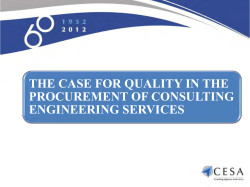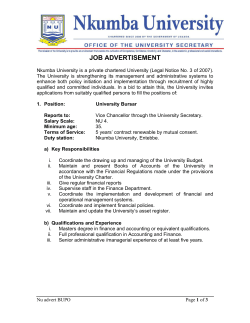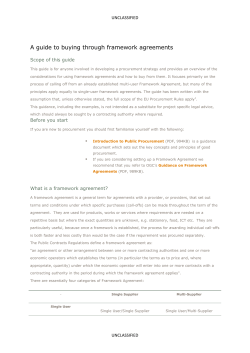
Rethinking Construction
School of Architecture and Building Engineering Rethinking Construction Review of traditional construction models and a comparison of product development processes with other industries Procurement What is procurement? Procurement is defined as the process from the completion of design to the successful handover of the building. It is also the contractual and financial arrangements between the parties. Types of procurement Some examples of procurement……. -- Traditional procurement -- Management contracting -- Design and Build procurement Traditional procurement The traditional form of procurement is where the designer does not have a direct link with the specialist and all communication is via the main contractor who in many cases will not accept design liability Traditional procurement The basic hierarchy CLIENT ARCHITECT SPECIALIST CONSULTANTS TENDERING STAGE: SELECTION OF PRINCIPAL CONTRACTOR PRINCIPAL CONTRACTOR DOMESTIC SUB CONTRACTORS NOMINATED SUB CONTRACTORS Traditional procurement Key features Professionals are empowered to use best practice defined by their own professional bodies and education The basic workforces in general play an inactive role towards the design and planning process Such an environment generally encourages an adversarial attitude among the design teams. In terms of cost benefits, reduction of up to 30% can be achieved. While a reduction of 40% in delivery, time can be achieved but there is a little change in the quality of the product Innovative Construction Procurement Gives the client more input into cost and quality Client needs a management with strong leadership and teamwork qualities in order to produce what is expected. Hence, the client, in terms of design and construction, has only one organisation to deal with. Such procurement was introduced to accommodate forever increasing diversity, complexity and standardisation of building techniques Innovative Construction Procurement Direct involvement of the manufacturer in terms of design, costing and logistics There is also a close relationship between the manufacturer and the main contractor in terms of delivery and site installation The management structure of this form of procurement is organised hierarchically according to the stages of product development. Innovative Construction Procurement Key points Key decisions need to be made early in the procurement process to avoid expensive alteration to the design Decisions also need to be made on environmental implication and site related benefits in order to reduce its impact on neighbouring properties and site traffic It is important to note that because this system of procurement rely heavily on the prefabrication process, therefore the initial space planning, subsequent detailed design, service integration and co-ordination are critical. The design needs to be completed prior to the commencement of manufacturing Integrated procurement systems Integrated Procurement System is defined as an arrangement where one contracting organisation takes sole responsibility, normally on a lump sum fixed price basis, for the bespoke design and construction of a client’s project (e.g. D + B). The fundamental characteristics of this system are the responsibility for the design and construction lies with one organisation, reimbursement is generally by means of a fixed-price lump sum and the project is designed and built specifically to meet the need of the client Integrated procurement systems: advantages Single point of contact between client and contractor If client’s requirement is accurately specified, certainty of final project cost is achieved then the cost would is then less when compared with other procurement methods Design and construction is overlapped which results in improved communications being establish between contractor and client. These two characteristics enable shorter, overall project periods to be achieved and project management efficiency to be improved Integrated procurement systems: disadvantages The client’s brief is often ambiguous and does not convey exactly what he is proposing to the contractor. The absence of a bill of quantity makes the valuation of variations extremely difficult and restricts the freedom of clients to make changes to the design The client’s control over the aspect of design and aesthetics of the building is less when compared with other methods of procurement Management-Orientated Procurement Systems This system is defined as a process whereby an organisation, normally construction based, is appointed to the professional team during the initial stages of a project to provide construction management expertise under direction of the contract administrator Management-Orientated Procurement Systems Key points The contractor is appointed on a professional basis as an equal member of the design team providing construction expertise Reimbursement is based on a lump sum or percentage fee for management services plus the prime cost of construction The actual cost is carried out by works or package contractors who are employed, co-coordinated and administered by the management contractor Management-Orientated Procurement Systems - advantages Commencement of the project is accelerated, which in turn, should enable earlier completion to be achieved. Early advice can be obtained from the contractor/manager on design, buildability, programming, materials availability and together with general construction expertise. This system has a high degree of flexibility to allow for delays, variations and rescheduling of work packages. Since the financial structure of this system is fragmented, the monetary failure of any works contractor will only have limited effect overall process. Management-Orientated Procurement Systems - disadvantages Elevation of the contractor to the status of a client’s adviser/consultant with the result that the contractor’s contractual liabilities are limited, in the same way as other members of the professional team, to accepting responsibility of negligence in the performance of his management role. Although the contractor/manager is responsible for supervising construction and ensuring that work is built to the standards identified by the design team, the fact that his obligations are limited to his management capabilities means the client is liable for the cost of remedying any defects. Management-Orientated Procurement Systems - disadvantages The whole issue of maintaining quality control is problematic when using this procurement system. The client may need to appoint additional site supervision to avoid difficulties in determining the responsibility for defects and to ensure that the specified quality is achieved. The client does not have a firm price tender available before commencing work although both private and public accountability can be partially satisfied as the majority of the construction cost can be subject to competitive tender. Lean Principles Task time production One-piece flow Pull Production
© Copyright 2025









